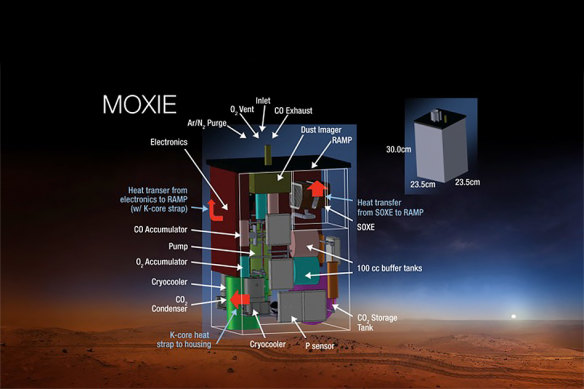
MOXIE twice ran an analysis of the oxygen it had created and found it to be pure as well as meeting the target of six grams of oxygen per hour.

MOXIE is an exploration technology investigation that will produce oxygen from Martian atmospheric carbon dioxide.Credit:NASA
Scientists are trying to manufacture essential materials on different planets, to save having to transport them from Earth.
The atmosphere on Mars is fatal to humans and unable to support life, so reliably producing oxygen is essential to the success of future missions.
The reliability and consistency of MOXIE’s oxygen production has proven the principle, and engineers want to scale it to make several tonnes of oxygen, like a robotic forest. In the future, a ramped-up version of MOXIE may be sent to the Martian surface ahead of a human mission to create oxygen stores.
While it can be inhaled by astronauts, they will also need around 25 tonnes of oxygen to launch a rocket from the Martian surface for any return home.
Loading
Instead of running in one hour bursts, the technology would operate around the clock.
Professor Jeffrey Hoffman, the MOXIE deputy principal investigator from MIT’s Department of Aeronautics and Astronautics, called the data, published in Science Advances, “historic”, adding: “This is the first demonstration of using resources on the surface of another planetary body, and transforming them chemically into something that would be useful for a human mission”.
Running MOXIE at various times in the Martian year and during different times of day was a key challenge to prove it can make oxygen under drastically changing conditions.
“The atmosphere of Mars is far more variable than Earth,” Hoffman said.
Loading
“The density of the air can vary by a factor of two through the year, and the temperature can vary by 100 degrees. One objective is to show we can run in all seasons.”
Michael Hecht, principal investigator of the MOXIE mission at MIT’s Haystack Observatory, said the only time of day they have not run MOXIE is dawn or dusk, when the temperature is rapidly increasing or decreasing.
However, he said the team had “an ace up the sleeve” to cope with tricky conditions, adding: “Once we test that in the lab, we can reach that last milestone to show we can really run any time.”
NASA hopes to have humans on the Moon within 20 years and Elon Musk, the billionaire founder of SpaceX, hopes to create a permanent colony there.
The Telegraph, London









 Add Category
Add Category